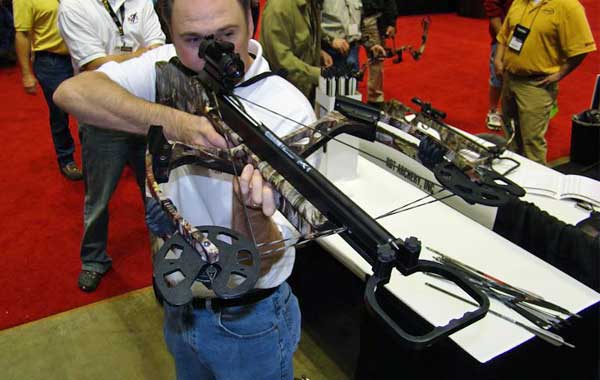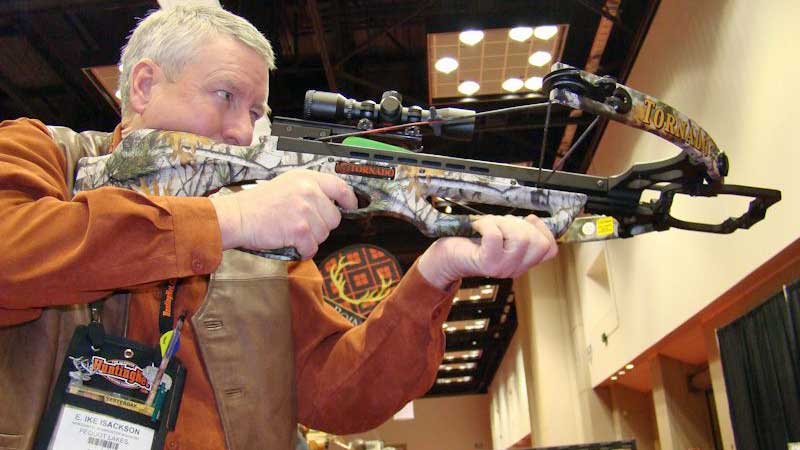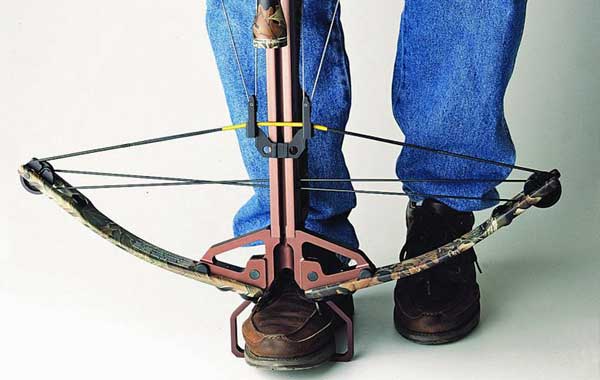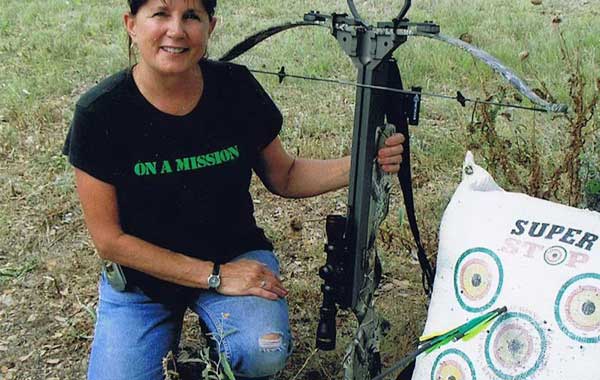“The crossbow is nothing more than a 30.06 that shoots arrows!”
I don’t know how many times I have heard that statement being made, but it seems just as popular today as it was years ago, given the faster and more powerful crossbows that are being manufactured by the crossbow industry. But even with the greater power available in the newest crossbows coming off the assembly line, there are major limitations that the person interested in picking up the crossbow should be fully aware of.
What I will present here is a abbreviated list of what you will discover when you purchase your first “he-man” muscle bow. It should be understood that not all of these characteristics may occur in every muscle bow, but the following are things that you should be looking for as you begin to develop a working relationship with your new bow.
Because of the physics of crossbows, there are certain limitations that one can enhance to make them more powerful. A crossbow has a shorter power stroke, thereby producing less kinetic energy. For years, the maximum draw weight for a hunting crossbow was 150 lbs. But then mankind decided they wanted faster, more powerful crossbows for the obvious reasons: to be able to shoot flatter, faster and further.
With a crossbow, there are just a few of ways that can be done. The first is to simply boost the draw weight. The once maximum draw weight of 150 lbs has, as of 2015, reached a new apex of 290 lbs, nearly doubling the peak of crossbows at the turn of the century.
Another method of squeezing more juice out of a crossbow is to increase the length of the power stroke. The longer distance the sting pushes the arrow upon release, the more kinetic energy that is stored in the arrow. The more kinetic energy, the faster, flatter and the further the arrow will go.

Radical Cams like those on the Scropyd Crossbows will give you greater speed with lower draw weights.
However, you can only build a crossbow so long before it becomes unmanageable to shoot. Again, the physics of a crossbow makes it frontend heavy to begin with; and using a crossbow with a 30” power stroke like that of a vertical bow, would make it almost impossible to steadily hold up the front end, regardless your strength. This disadvantage would make crossbow hunting impossible for 99% of women, children and most of us old guys.
The third method is by using radical cams, which increases the draw length without making the crossbow stock longer. Scorpyd crossbows are an excellent example of this, being able to obtain 300 fps with only a 100 lb draw weight using the radical cam and their patented reverse draw design.
From a personal standpoint, I consider any crossbow that shoots over 325 fps to be a muscle bow. The essence of bowhunting has always been about getting to within 30 yards or less from the quarry by honing one’s hunting skills and knowledge of the species being hunted. The closer the shot, the better the chance of success, but the newer bows being manufactured, both horizontal and vertical, are making longer shots with deadly accuracy possible due to the rise of the modern muscle bow.
There is a down side to these new age monsters however, that should be taken into consideration, especially if you are in one of the categories that make up the bulk of crossbow hunters. Most folks that can shoot a vertical bow do, simply because the compound bow is the superior weapon to the crossbow. The majority of the crossbow users is made up of women, youngsters and old folks and the muscle bows can have some very critical draw backs for these three groups.

Don’t order from a catalog, but go to an outlet where you can measure the characteristics of the bow and shoot it.
Size and weight are the first considerations to be given. A lot of these crossbows are built like Fort Knox, which means that they are heavy and cumbersome; a distinct disadvantage for most crossbow hunters. Don’t just buy a crossbow from a mail order catalog, but instead go to an archery proshop or sporting goods store where you can pick up the bow, shoot it and measure the fit to your body; as well as going through the procedures of shooting it. Find one that fits your personal needs and that does not exceed your body’s physical limitations.
The next feature that should be considered is draw weight. With an industry peak of 290 lbs, you had better be sure that you can comfortably cock your bow, either by hand or with the aid of either a string or a crank cocking device. You don’t want to be standing there like Dirty Harry, saying, “This is the most powerful crossbow in the world, but I can’t get it cocked”. You want to be able to cock it easily and often so that long practice sessions don’t put you into the hospital or permanently disable you.

Most users will need either a cocking rope or crank device to cock a muscle bow.
The next consideration is going to be the overall safety of the bow. Because of the increased and concentrated power of a muscle bow, it is far less forgiving. Even the simple mistakes made in normal use or maintenance could create serious problems. Only one word can describe a dry-fired muscle bow…KABOOM!
And when the dust settles you can pretty much guarantee that you crossbow will be in pieces. Every phase and operational instruction in the manual must be strictly followed and adhered to. The very first thing you want to do before every touching the bow is to study, not just read, but study your owner’s manual from cover to cover.
If you whack your fingers with a muscle bow, you will probably do much more than turn them black and blue, you could even loose one! I understand, however that the medical profession is doing great things as far as reattaching severed digits these days. When you are using a muscle bow, stay awake! A mistake with this type of bow is guaranteed to leave a lasting impression or even worse, a gaping, empty space on your hand.
Maintenance of your muscle bow is going to be a top priority. String wax, rail lube and oil to the mechanical parts are going to be far more important and require a more rigid adherence than a lesser bow because of the increased power and stress to the moving parts. That additional stress created by higher poundage on the limbs, string, cables and trigger mechanism of your bow will push those elements to the maximum, making maintenance very important. Maintenance is still important on any crossbow, but a lighter crossbow is more forgiving.
Most of the muscle bows call for a heavier arrow, some even a special arrow. This means that if you know nothing about crossbow arrows other than they come three to a pack from Wal*Mart, you had better hone you crossbow ballistic knowledge. With a muscle bow, shooting an arrow that is too light may produce the same results as you would get when you dry-fire your bow. Here again, your owner’s manual will tell you exactly what arrow you should be using. Don’t question why, just do it, because that weight is recommended for very specific reasons.
The last thought I would like to leave you with is that the muscle bow, whether vertical or horizontal, will shoot farther, faster and flatter, but they are normally even louder than a lighter crossbow, which remains the normal tendency for crossbows. In my humble opinion, no shot taken at a live target, especially animals like the whitetail deer, should ever be taken over 40 yards.

Women, youngster and older shooters would do well to stick with a crossbow with a lighter draw weight.
An animal can jump completely out of the path of an arrow, even a bow that shoots over 400 fps. That speed doesn’t come close to the speed necessary to be faster than an animal. The further the animal is away from you, the more time it has move away from the aiming point. The closer the live target is, the greater your chances of getting an arrow into it. There is also less chance of arrow deflections because you are better able to see sticks and brush will destroy shot accuracy.
Remember crossbow hunting is still an up close and personal sport. If you want to be able to make shots 50 yards or longer, buy a shotgun or a rifle, which is specifically designed for making long-range shots. Forty yards or less is the recommended distance for an ethical shot with a crossbow.






